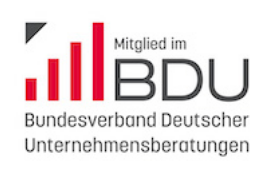Services
How leadership works today
Leadership is changing. The task of managers today is to act as coaches and mentors, enabling and promoting the development, personal responsibility and self-organization of employees and teams. In addition to the „classic“ supervisor function, lateral forms of leadership are becoming increasingly important: leading in the matrix, leading in agile contexts, leading in projects, leading virtually and at a distance.
Our offer
Even experienced managers are faced with ever more rapidly changing requirements, which make it necessary to critically examine one’s own leadership understanding and behavior, to anchor already proven leadership tools even more firmly in everyday life and to acquire new leadership techniques. The content focuses on managing change processes, developing and communicating an inspiring vision and strategy for one’s own area, developing one’s own employees, retaining top performers over the long term, promoting cross-departmental cooperation, and creating an environment that is motivating, inspiring, and experienced as meaningful for employees.
Newly appointed managers are faced with the challenge of making the transition into the leadership role in such a way that, on the one hand, they establish themselves clearly and confidently as leaders in the „first 100 days“ and, on the other hand, they appreciate what already exists and do not „overpace“ it. They need to sharpen their own understanding of leadership, clarify mutual expectations, demonstrate a clear value system, quickly gain the trust of team members and gain acceptance in their new role. In addition, newly appointed managers face the task of defining standards and rules of the game together with the team, establishing suitable information, communication and feedback processes, identifying potential areas of conflict at an early stage and building good relationships with the relevant stakeholders.
In addition to the „classic“ supervisor function, lateral forms of leadership without authority to issue directives are gaining enormous importance, for example in matrix constellations, in projects or in overlapping, cross-functional functions. Moreover, lateral leadership often takes place virtually, across locations and at a distance. For lateral leaders, it is important to find a good mix of assertiveness and diplomacy, clarity and tact when it comes to winning over colleagues from other areas for the topics and tasks. It is necessary to address different personalities in a differentiated manner, to establish commitment, obligation and, in particular, adherence to deadlines, to motivate the (project) team over longer periods of time to achieve demanding goals, to structure efficient meetings, to reconcile day-to-day business and project work time and again, and to manage possible conflicts of goals, interests and resources with confidence.
Leading Leaders requires a more coaching-oriented leadership style, which specifically supports the own Direct Reports in acting even more successfully in their leadership role and in increasing their own degree of effectiveness. The specific application of the coaching tools suitable for this requires a high degree of maturity as well as the ability and willingness to perceive one’s own leadership behavior as well as that of the employees in a differentiated manner and to develop it further in a targeted manner. Leading Leaders also means working together on the leadership and corporate culture and considering its further development as the focus of one’s own role as a leader.
A high degree of self-organization in teams also requires leadership. This relates less to mastering individual tools and more to creating an environment that makes self-organization possible in the first place – ideally as a process of co-creation with the team. Emotional competencies are thus gaining in importance. Building and maintaining trusting relationships, empowering employees, the willingness to „let go“ as a leader, as well as authenticity and modesty: away from status thinking and positional power – towards defined roles with a focus on the respective strengths and potentials of employees.
Today, change processes usually no longer have a clearly defined starting point or end. Consequently, „classic“ approaches to change management reach their limits and „Leading Change“ becomes a permanent task for managers. It is necessary to deal with a wide range of emotional reaction patterns (fear, pain, anger, but also joy) on the part of employees in a differentiated manner, to convey the purpose of the transformation in a credible and convincing manner, to master various formats of change communication, to get to implementation quickly, to convey a sense of achievement, to celebrate successes together, to enable the personal development and growth of employees and, in particular, to deal with setbacks in a solution-oriented manner and to view them as learning opportunities.
The impact of one’s own personality is crucial for the credibility and effectiveness of leaders. Leading oneself is a prerequisite for employees to be willing to be led. It is a matter of knowing one’s own emotional reaction patterns and personality programs and controlling them according to the situation, of strengthening one’s own resilience in order to be able to act confidently in pressure and stress situations. In dynamic and volatile environments, courage is needed to make decisions under uncertainty. At the same time, it is important to give employees the benefit of the doubt, create bonds and build stable relationships („first connect, then lead“) in order to develop a climate of psychological security in one’s own area or team. Only in this way will employees feel bound to the company and encouraged to make a committed contribution.
Leading at a distance places very special demands on managers: How do I communicate digitally with my employees? How can I make virtual meetings lively and inspiring? How do I stay in touch and meet the different needs and working styles of my employees? How do I strike a good balance between trust and commitment in the implementation of tasks and projects? How do I recognize individual stress, motivation or performance crises at an early stage? How do I promote and support the self-organization of the team? How do I create bonding and cohesion in the team and ensure that cooperation and support processes take place?
Only those who are psychologically resistant and thus resilient can cope with stress and strain. The relevant factors such as optimism, acceptance, solution orientation, self-efficacy, connectedness and future orientation act as a „filling station“ to replenish one’s own reservoirs. This applies equally to leaders and employees. In addition to self-care, however, managers also have the task of shaping the framework conditions and accompanying circumstances in the company in such a way that everyone has the opportunity to strengthen their resilience in the first place. Only in this way can it be possible to expand mental health in the company and thus support a low rate of sickness and at the same time strengthen the loyalty of employees to the company.

